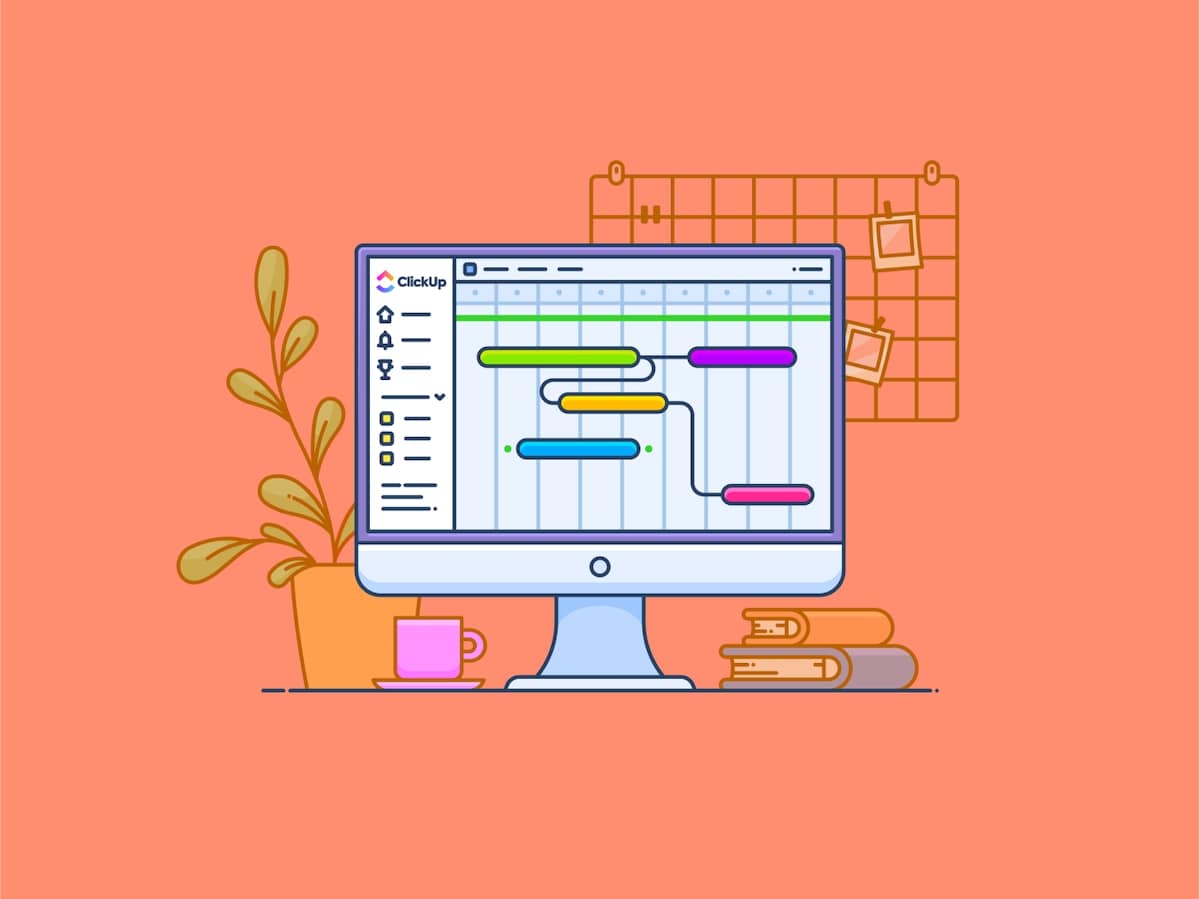هناك الكثير في إدارة المشروع أكثر بكثير من مجرد تعيين المهام ومراجعتها. فهناك تحقيق التوازن بين أعباء عمل أعضاء الفريق، وإنشاء تدفقات العمل التي تتوقع وتتجنب العوائق التي تعترض طريقه، وصياغة إجراءات التشغيل الموحدة للإجراءات.
مع وجود الكثير من الأجزاء المتحركة، فإن مراقبة المشروع والتحكم فيه من المكونات الأساسية لأي نشاط تجاري ناجح.
مع وجود نظام فعّال والأدوات المناسبة، لا يجب أن تكون مراقبة مشاريعك عملاً روتينيًا بالنسبة لشركتك أو مدير المشروع. ألست متأكداً من أين تبدأ؟
سنتعمق هنا في ماهية مراقبة المشروع في الواقع وسبب أهميتها لفريقك. بالإضافة إلى ذلك، سنقدم لك نصائح حول أفضل الممارسات، وسنوضح لك كيفية إنشاء خطة مراقبة المشروع والتحكم فيه في بضع خطوات سهلة. ✨
ما هي مراقبة المشروع والتحكم في إدارة المشاريع؟
تتمحور مراقبة المشروع والتحكم فيه حول تتبع تقدم المشروع. إنها واحدة من خمس خطوات رئيسية في دورة حياة المشروع التي تجري جنبًا إلى جنب مع مرحلة التنفيذ.
فيما يلي تفصيل سريع لمراحل دورة حياة المشروع:
- بدء المشروع: تحديد نطاق المشروع والمعالم الرئيسية للمشروع وأصحاب المصلحة والمخرجات
- تخطيط المشروع: إنشاء خارطة طريق لتحقيق أهداف المشروع، بما في ذلك صياغة خطة المشروع، وتحديد الجدول الزمني للمشروع، وتحديد مخاطر المشروع
- تنفيذ المشروع: بدء المشروع من خلال إشراك أعضاء الفريق وتعيين المهام وإدارة الاتصالات
- مراقبة المشروع والمراقبة: جمع البيانات من المشروع، وتحليل النتائج، والتصرف بسرعة لمعالجة أي تحديات
- اختتام المشروع: اختتم المشروع من خلال الاجتماع مرة أخيرة لمراجعة المقاييس وما الذي سار بشكل جيد وما الذي ستغيره في المستقبل
تتمحور مراقبة المشروع حول جمع البيانات من المشروع وتقييمها من البداية إلى النهاية. ويشمل ذلك تصور وتقييم نجاح مهام المشروع الفردية والخطوات التي تشكل المشروع الأكبر نطاق المشروع .
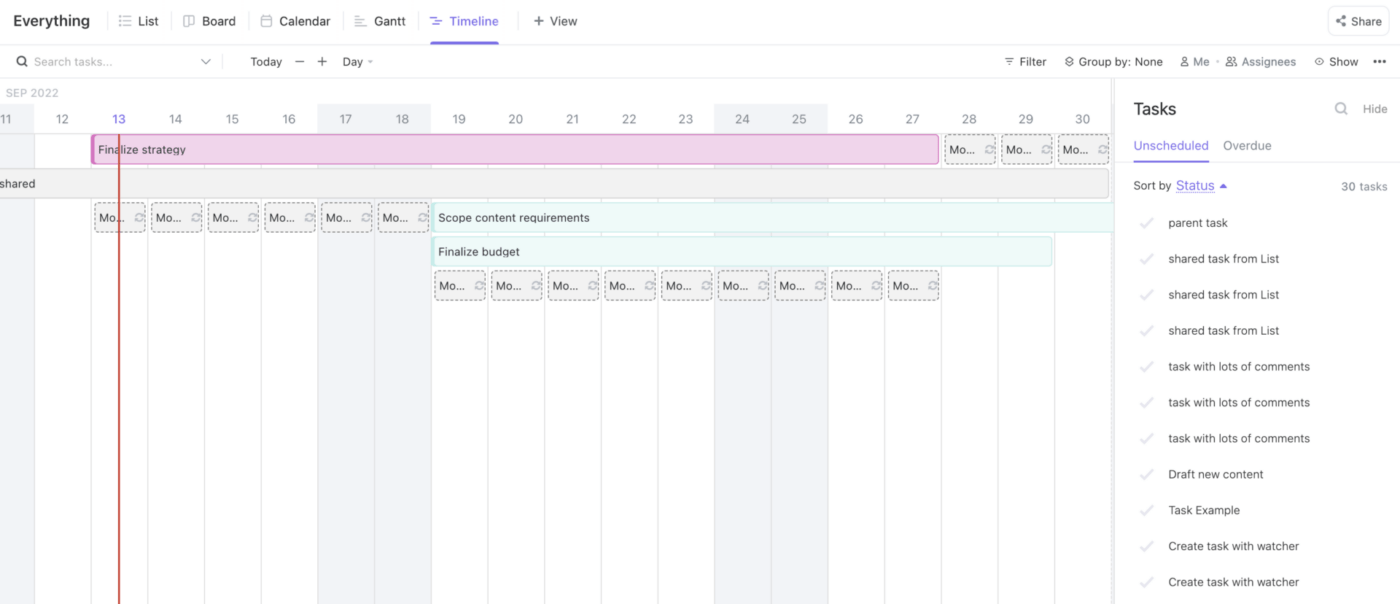
استخدم طريقة عرض المخطط الزمني لعرض أهم المعلومات بالنسبة لك وعرض المهام حسب الترتيب الزمني أو الأبجدي أو حسب تاريخ الاستحقاق أو تاريخ البدء
تتضمن عملية التحكم أخذ هذه الأفكار وتحويلها إلى عناصر عمل وإجراء تغييرات لضمان سيرها بسلاسة. في عالم الأحلام، سيسير كل مشروع وفقًا للخطة. لكن الواقع هو أن معظم المشاريع ستواجه عوائق على طول الطريق:
- قد يتعرض أحد أعضاء الفريق لحالة عائلية طارئة تبعده عن العمل
- قد تتجاوز التكاليف التوقعات بسبب مشاكل في سلسلة التوريد
- زحف النطاق يمكن أن يؤدي إلى زيادة المنجزات من مشروعك وإبطاءالجدول الزمني للمشروع لمديري مشروعك
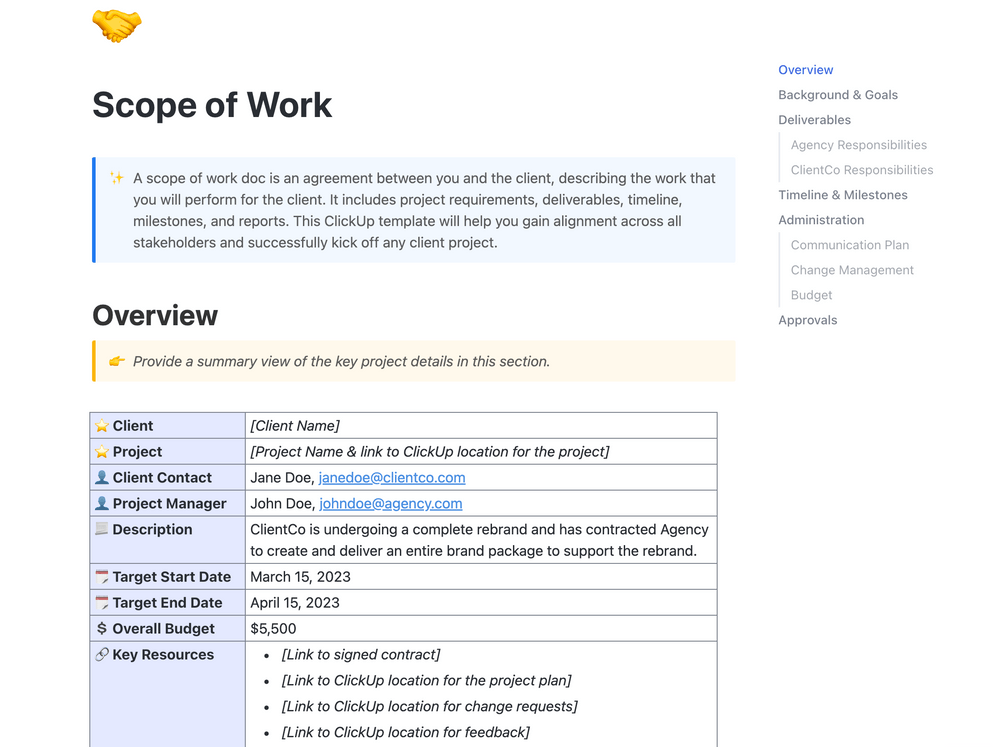
مكافحة زحف النطاق من البداية باستخدام اتفاقية نطاق العمل الخاصة ب ClickUp مهما كانت المشكلة، فإن مراقبة مشروعك تمنحك الوقت الكافي للتفاعل مع أي مخاطر محتملة. إذا ساءت الأمور، فإن البيانات التي جمعتها في هذه المرحلة لا تقدر بثمن لتبسيط الجهود المستقبلية وتحسين عملياتك. 💪
أهمية مراقبة المشروع لفريقك ## أهمية مراقبة المشروع لفريقك
مراقبة المشروع أمر بالغ الأهمية لنجاح أي مشروع. واحدة من الأسباب الرئيسية لفشل المشاريع هو عدم وجود تقييم أو إشراف.
إذا لم تتمكن من توقع المشاكل المحتملة أو رؤية المشاكل عند ظهورها، فلن تتمكن من اتخاذ إجراءات تصحيحية بسرعة كافية لإبقاء المشروع على المسار الصحيح. يجب أن يكون مديرو مشروعك على رأس هذا الأمر وإلا فإنك تخاطر بفشل المشروع والتأخير وتجاوز ميزانية المشروع.

تصور مقدار العمل المخصص للمساهمين الأفراد وكذلك كل فريق من فرقك باستخدام طريقة عرض عبء العمل في ClickUp
تساعدك مراقبة فريقك على الالتزام بالميزانية والجدول الزمني والمسار الصحيح. كما أنه يمنح مديري المشاريع رؤى حول أعباء عمل أعضاء الفريق المختلفين ويمكنه أن يُعلمك بنجاح المشاريع المستقبلية ومرحلة التخطيط الأولي.
من خلال المراقبة الفعالة، يمكنك معرفة ما يعمل بشكل جيد وما يحتاج إلى تحسين. ثم يكون لديك التحكم في إجراء التغييرات والتعديل حتى يستمر المشروع بسلاسة قدر الإمكان. 🛠️
كيفية إنشاء خطة مراقبة المشروع والتحكم فيه
من التخطيط مرحلة المشروع إلى التنفيذ، من المهم أن يكون لديك خطة للمراقبة والتحكم لإبقاء الأمور على المسار الصحيح. من خلال القيام بذلك منذ البداية، ستوفر على نفسك الصداع وستحصل على فرصة أكبر لإنجاز مشروع ناجح.
إحدى الطرق السهلة للبدء هي استخدام نموذج مثل خطة المراقبة والتحكم في مشروع ClickUp . يتميز بحقول مخصصة وروابط سريعة لأساسيات المشروع، بما في ذلك هياكل تقسيم العمل وخطة المشروع ومعلومات الفريق.
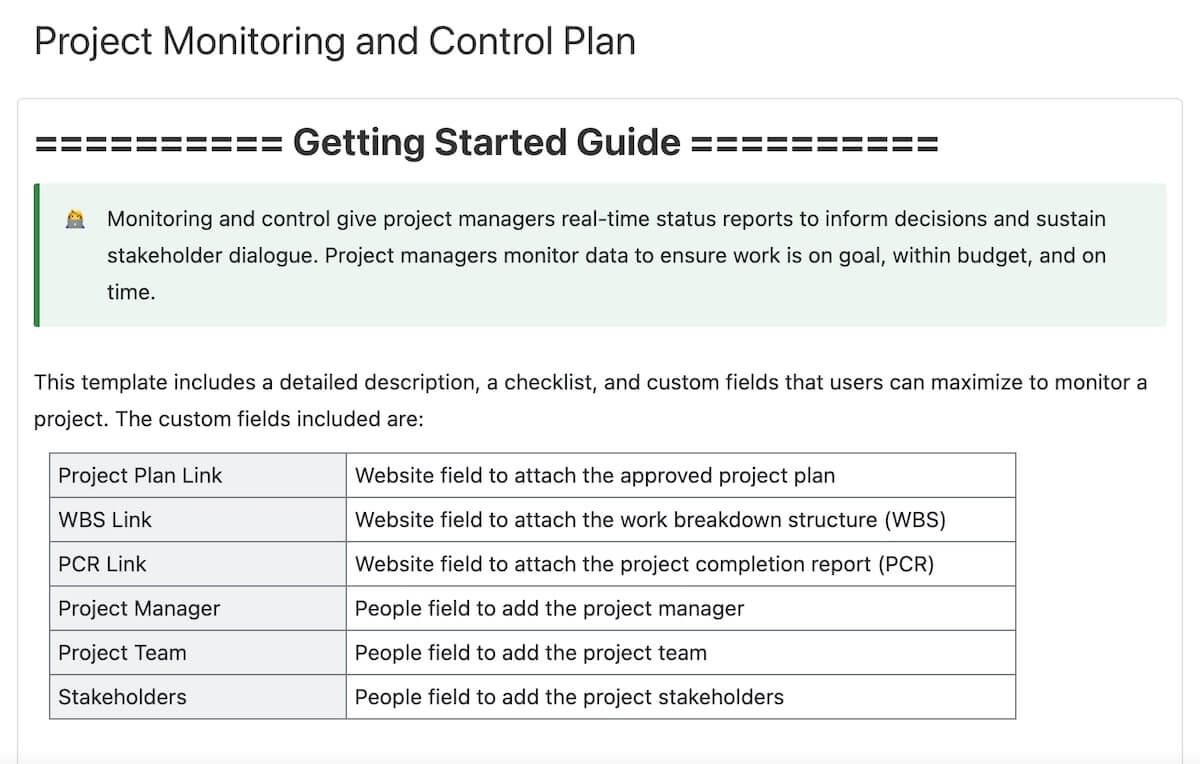
تسهّل خطة المراقبة والتحكم في المشروع من ClickUp إنشاء هياكل تقسيم العمل، والربط بخطة المشروع، وتتبع تعاون الفريق
سواء اخترت استخدام قالب أم لا، هناك عدة خطوات أساسية لإنشاء خطة مراقبة وتحكم ناجحة. تابع القراءة للحصول على دليل تفصيلي خطوة بخطوة لصياغة خططك الخاصة في دقائق. 👀
1. إنشاء خطة
من أجل عملية مراقبة ناجحة للمشروع، يجب أن يكون لديك خارطة طريق أو خطة لكيفية تحقيق مخرجات المشروع . يجب أن تتضمن خطة إدارة المشروع خطوات لمراقبة المشروع وتقييمه والتحكم فيه. وهذا يعني وجود نظرة ثاقبة للمشروع ككل وكذلك المهام الفردية وطريقة لتحديد المشكلات المحتملة.
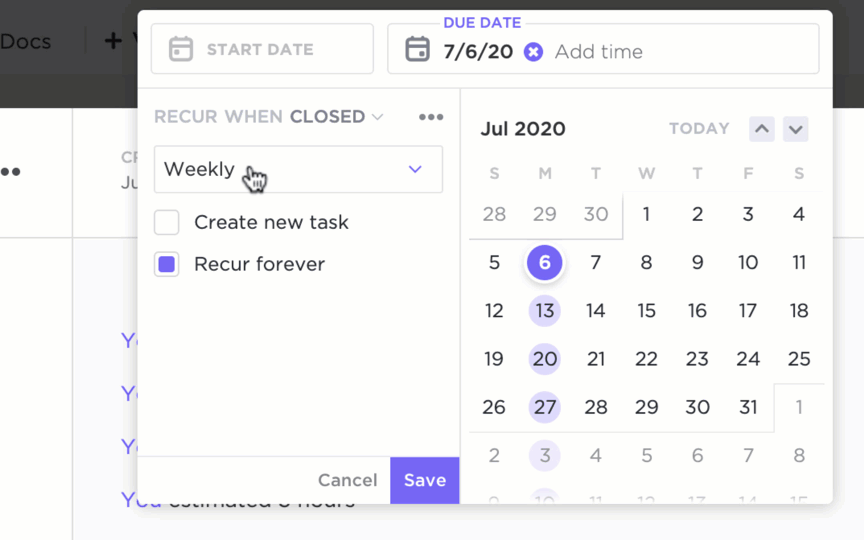
تعيين المهام لتكرار المهام حسب الوقت أو الحدث في ClickUp
استخدام ضوابط المشروع لإنشاء خطة خاصة بأهدافك. فيما يلي بعض الأمور التي يجب معالجتها في هذه المرحلة من عملية المراقبة والتحكم.
إنشاء إطار عمل لإدارة جميع مهامك ذات الصلة وتنظيمها والإشراف عليها
أنت بحاجة إلى مركز يمكنك من خلاله تتبع جميع المهام الفردية والبيانات ذات الصلة بالمشروع. مع أدوات إدارة المشروع مثل ClickUp، يمكنك بسهولة معرفة من يعمل على ماذا، ومتى يحين موعد استحقاق المهام، والوصول إلى إجراءات التشغيل الموحدة في مكان واحد.
خلال هذه المرحلة، يجب أن تتناول إدارة الموارد، ونطاق المشروع، والمخرجات، وتكاليف المشروع. بشكل أساسي، يجب أن تخطط للمشروع من البداية إلى النهاية، مع إيلاء اهتمام وثيق لأي مجالات قد تنشأ فيها مشاكل.
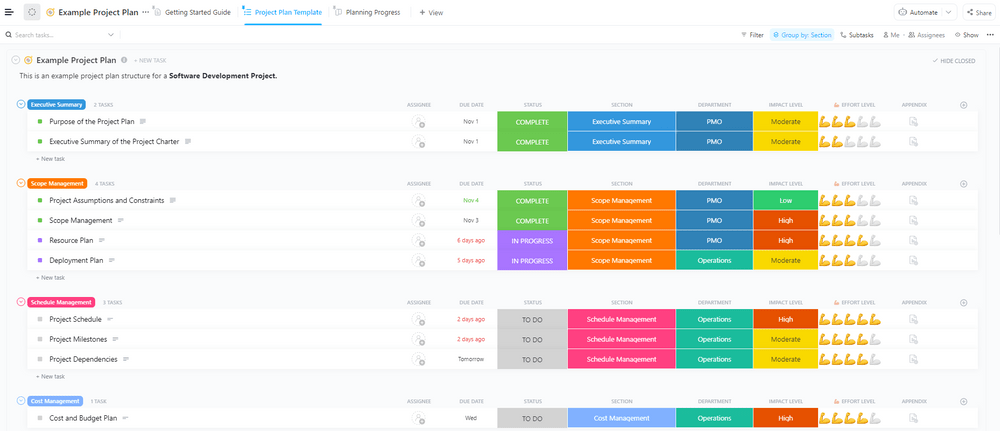
كليك أب خطة المشروع قالب يساعدك على بدء مشروعك التالي بشكل صحيح
استخدم نموذج نموذج خطة مشروع ClickUp مثال على خطة المشروع لإزالة التخمين من تخطيط مشروعك من خلال نموذج سهل الاستخدام وشامل. اكتسب الثقة وتأكد من بقاء مشروعك على المسار الصحيح من البداية وحتى الانتهاء.
تعيين المسؤولية حتى يعرف الجميع مسؤولياتهم
سواء أكنت تدير مشروعًا كبيرًا عبر الأقسام أو تعمل مع فريق أصغر، ستحتاج إلى تعيين المسؤوليات. حدد من المسؤول عن ماذا وكيف من المتوقع أن يقدموا تقاريرهم عن حالة المشروع .
يمكن أن يكون تعيين المشاريع توازنًا صعبًا بين الإفراط في إخطار أعضاء الفريق وعدم التواصل بشأن مسؤولياتهم. يمكن لمديري المشاريع الاستفادة من الميزات التي تسمح لهم بتعيين تعليقات على المهام حتى يعرف أعضاء الفريق متى ينتظرهم شيء ما.
حوّل التعليقات إلى مهام ClickUp أو قم بتعيينها لتحويل الأفكار إلى عناصر عمل على الفور
قم بإنشاء معايير تقييم لفهم كيفية نجاح فريقك
ضع خطة تقييم للمشروع. هذه الخطوة ضرورية لتحديد العقبات التي تعترض طريقك والحصول على وقت كافٍ لتعديلها.
أجب عن أسئلة مثل
- كم مرة ستقوم بالتقييم؟ هل سيكون مرة في الأسبوع أم مرة في الشهر؟
- كيف ستجمع الملاحظات؟
- ما هي عملية طلبات التغيير؟
- ما هي أنواع التقارير التي ستحتاجها لتقييم تقدم المشروع؟
2. تقسيم العمل
بمجرد أن يكون لديك خطة للمشروع، فقد حان الوقت للبدء في تعيين المهام والمهام الفرعية لأعضاء فريق المشروع. ستحتاج إلى تحديد تواريخ الاستحقاق والتوقعات لكل خطوة في المشروع.
حافظ على تنظيمك من خلال تجميع المهام حسب المرحلة أو القسم اعتمادًا على كيفية إدارة المشروع. إليك كيف تستخدم الفرق لوحات معلومات ClickUp للبقاء منظمًا وتعيين مهام المشروع:
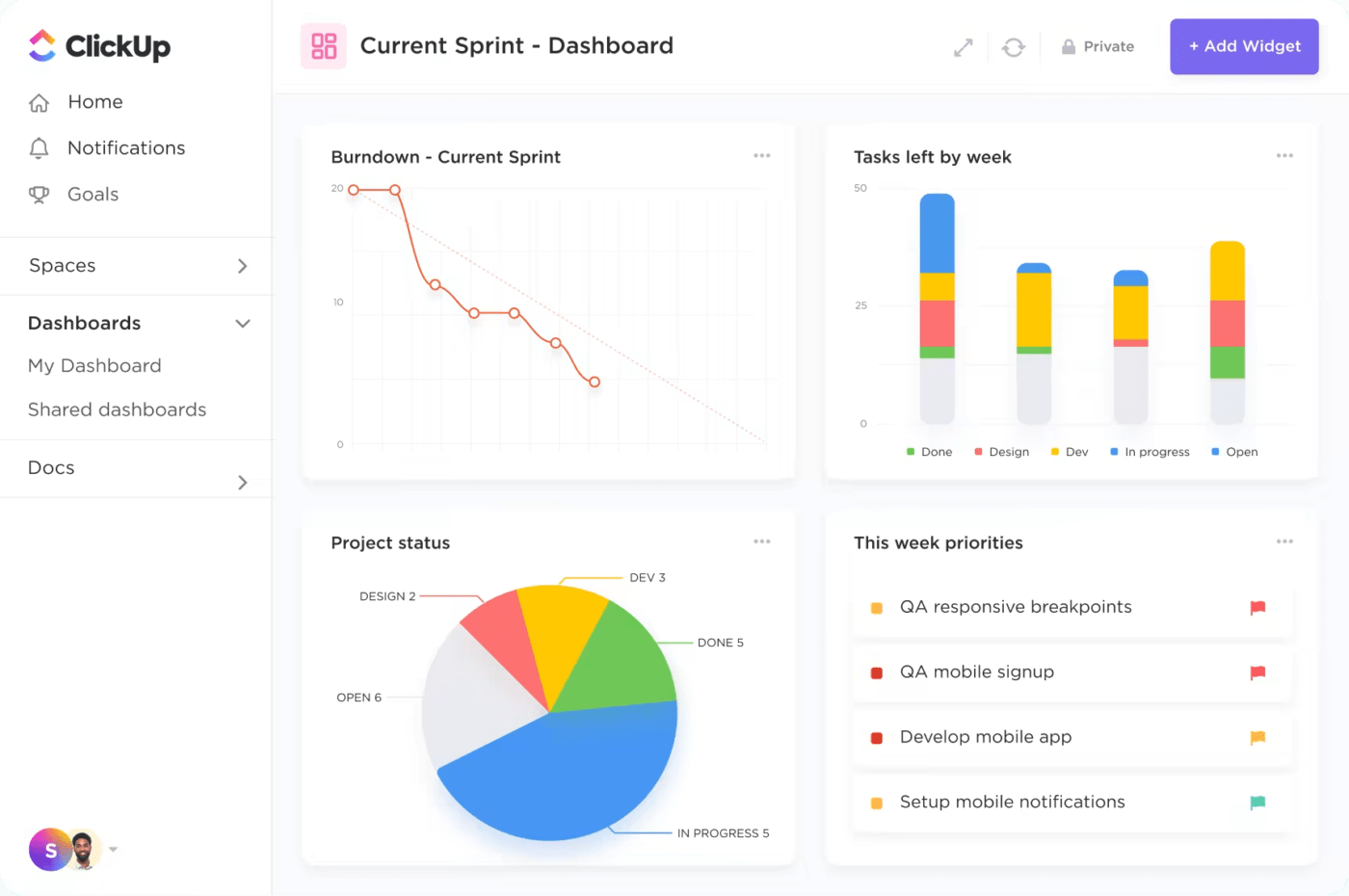
تتبع ومراقبة المهام والموارد والتقدم المحرز في المشروع في عرض لوحة معلومات ClickUp لوحات معلومات ClickUp طريقة سهلة لإنشاء مركز تحكم يضم جميع مهام مشروعك. أنشئ مخططات بيانية مخصصة للحصول على نظرة عامة مرئية للمهام الأسبوعية أو المراحل المختلفة للمشروع.
تحدد ميزة تتبع التقدم المحرز الاختناقات، وتتيح طريقة عرض عبء العمل مراقبة الموظفين -بما في ذلك رؤية عرض النطاق الترددي للموظفين حتى تتمكن من التقييم والتعديل حسب الحاجة.
ضمن لوحات معلومات ClickUp Dashboards، هناك مخططات جانت للاطلاع بسهولة على الجدول الزمني للمشروع، وما الذي يسير على المسار الصحيح، وما الذي يتأخر إنجازه. استخدمها لمراقبة الوقت المستغرق لإكمال المهام وإلقاء نظرة سريعة على تبعيات المهام.
مكافأة:
_/مرجع/ مدونة؟ p=57870_ الاستعانة بمصادر خارجية لإدارة المشاريع *%! : في وقت مبكر، قم بإنشاء عملية لمن سيتخذ القرارات. قد تكون أنت أو عضو آخر من أعضاء الفريق، وقد يكون هناك أكثر من صانع قرار واحد لجوانب مختلفة من المشروع (على سبيل المثال، الميزانية والموارد وما إلى ذلك)
تقنيات مراقبة المشروع والتحكم فيه
بالإضافة إلى أفضل الممارسات لمرحلة المراقبة والتحكم، هناك أيضًا بعض التقنيات المفيدة التي تجعل مراقبة المشروع أسهل. هذه هي الأساليب المجربة والحقيقية التي تفيدك في عملية اتخاذ القرار عند وضع خطة المراقبة. ✍️
فيما يلي بعض أساليب الرصد والتقييم التي يمكنك وضعها في الاعتبار:
طريقة المسار الحرج (CPM)
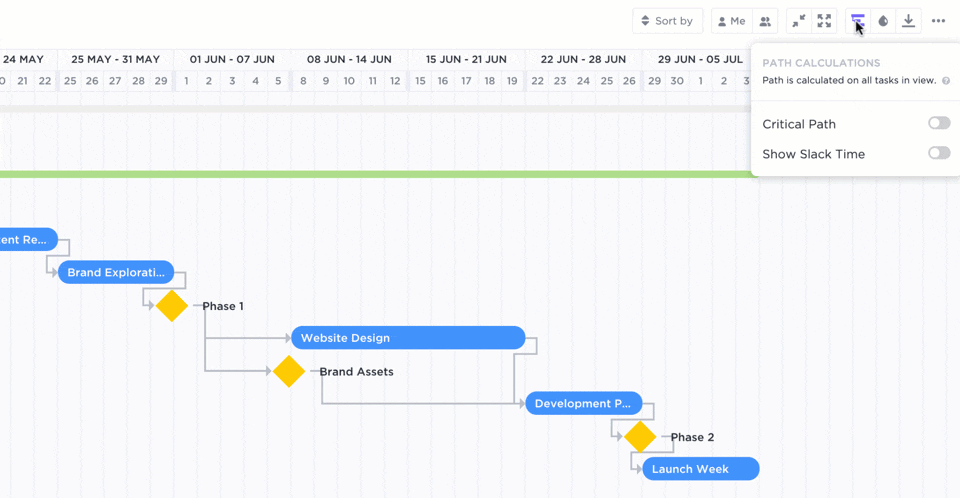
اعرض عبء العمل الخاص بك حسب المهام المتبقية في مسارك الحرج باستخدام مفتاح تبديل واحد في ClickUp!
تتضمن هذه الطريقة تقسيم المشروع إلى مراحل تقدم مختلفة باستخدام المخططات. المسار الحرج هو أطول تسلسل للمهام التي يجب إكمالها قبل انتهاء المشروع.
إنه في الأساس أطول خريطة طريق لإكمال المشروع ويتضمن تحديد الأنشطة وتبعيات المهام ومدة المهام ثم توصيل ذلك في مخطط.
إدارة القيمة المكتسبة
تقارن تقنية المراقبة هذه بين العمل المنجز حتى الآن والتكلفة مقارنة بتوقعات خط الأساس. في مرحلة التخطيط، تقوم بتعيين قيمة بالدولار - تسمى أيضًا التكلفة المدرجة في الميزانية للعمل المقرر (BCWS).
أثناء التنفيذ، تقوم بمقارنة التكاليف الفعلية بحجم العمل المنجز لمراقبة التقدم المالي والمادي.
مراقبة مشاريعك والتحكم فيها كالمحترفين
مراقبة إدارة المشاريع أمر معقد. فإلى جانب التخطيط، والتخفيف من المخاطر، والإدارة، عليك مراقبة المشاريع والتحكم فيها من البداية إلى النهاية. ليس ذلك فحسب، بل تتطلب منك مراقبة إدارة المشاريع اتخاذ قرارات مستنيرة بشأن أهداف المشروع مع إبقاء فريقك على نفس الصفحة (والقيادة على الأداء العام للمشروع ومؤشرات الأداء الرئيسية).
مع هذا الدليل المفيد، ستتقن مراقبة المشروع في وقت قصير. من صياغة الخطة إلى تتبع الأداء وإجراء التغييرات، يمكنك التحكم في نجاح مشاريعك في خطوات قليلة فقط. جرّب ClickUp اليوم للبدء في تبسيط نجاح إدارة مشروعك. من لوحات المعلومات سهلة الاستخدام إلى عروض المخططات التفصيلية، هناك أداة لمساعدتك في إدارة المشروع من البداية إلى النهاية. 🙌
